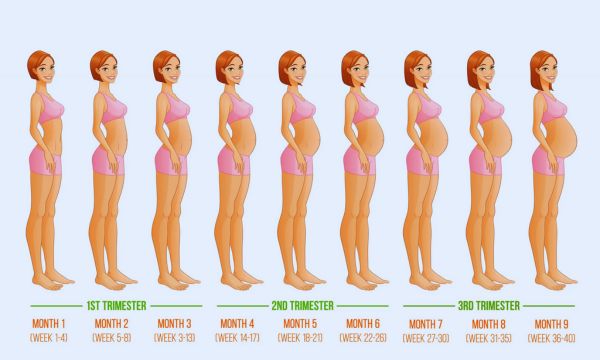Pregnancy: Symptoms, Types and Weekly Evolution
GestationPregnancy: Symptoms, types and weekly evolution. Stay up to date with everything in today’s post!
Did you know that pregnancy is divided into three trimesters? Pregnancy is a period of great changes and emotions, and it is important to stay informed about what will happen and the care needed throughout the journey. This event is unique and wonderful in the life of any woman, being responsible for the formation of a new being. In this article, we will explore the symptoms, types and course of pregnancy.
Pregnancy symptoms

Pregnancy: Symptoms, Types and Weekly Evolution
The gestation is a period characterized by a series of physical and hormonal changes in a woman’s body. Likewise, the psychology of the future mother may be affected. At the beginning of gestation, several changes may be more visible, allowing the woman to begin to suspect a pregnancy. However, as each body is a world apart, not all women feel the same or with the same intensity. In some cases, they don’t even feel anything different during the entire gestation period. It’s really enviable!
Below, see some of the most common symptoms that may indicate pregnancy:
- Delay in menstruation;
- Increased sensitivity in the breast region;
- Increased urinary frequency;
- Increased feeling of tiredness;
- Nausea and vomiting;
- Desire and aversion to certain foods;
- Change in appetite;
- Dizziness.
If you identify any of the symptoms, it is best to seek out a trusted doctor as soon as possible so that the suspicion can be confirmed. The sooner this is done the better, and prenatal care can be started immediately, which is essential to prevent complications during gestation.
Pregnancy classification
There are different ways to classify a pregnancy. Among the criteria most used by doctors and specialists are: .
Risk to mother and/or baby
Usual risk pregnancy: In this specific case, there is no major risk of gestation complications.
High-risk pregnancy: In this type of pregnancy, the baby or mother presents a greater risk to life. Therefore, prenatal care plays a fundamental role in ensuring that the pregnancy reaches its conclusion. High blood pressure and diabetes may be some of the factors responsible for a high-risk pregnancy.
Embryo implantation site
Topical pregnancy: The embryo develops in the uterine cavity, as normally happens in most cases.
Ectopic pregnancy: In this case, the embryo develops in a structure outside the uterus.
Number of embryos
Single pregnancy: Only one embryo is developing.
Twin pregnancy: Two or more embryos are developing. This means that the woman is expecting more than one baby.
Weeks of pregnancy
Normally, gestation is counted in weeks and to make the calculation, you need to know the date of the last menstrual period. Pregnancy on average lasts 40 weeks, with every 7 days after the date of the last menstruation being configured as a week.
However, it is worth highlighting that this count is not precise, that is, it cannot demonstrate the gestational age with complete certainty. Therefore, during prenatal consultations, doctors perform calculations and also observe the characteristics of the developing fetus during ultrasound, which is performed at least once a month.
Below is a table showing the relationship between months and weeks of pregnancy:

Pregnancy: Symptoms, Types and Weekly Evolution
Pregnancy week by week
Throughout gestation, the baby’s body is also preparing to survive outside the mother’s womb. Therefore, several changes occur to allow its survival, which ensures that at the end of the journey the baby is able to feed itself or breathe, just to name a few examples.
Therefore, some remarkable events occur throughout the weeks of pregnancy. Remembering that each gestation is unique, but development events are always expected to occur approximately in the weeks described below:
- Fourth week: At this stage of gestation, the baby’s heart begins to beat and it is possible to observe the place where the arms and legs will develop. The size of the baby at this stage is approximately the size of a grain of rice!
- Eighth week: Now the baby is approximately the size of a pea, and his ears, fingers and internal organs are formed.
- Ninth week to 12th week: At this stage, the brain begins to function, with the baby being able to carry out some activities, such as moving its limbs.
- 14th week: The baby is now able to move his hands and breathing movements are now possible.
- 15th week to 16th week: From now on, the mother begins to feel the baby’s movements. The baby’s skin, previously transparent, begins to thicken.
- 17th week to 18th week: At this stage, the baby is already able to suck, swallow and blink. The mother is able to notice her child’s hiccups, which is a very normal activity.
- 20th week to 24th week: Food becomes even more intense and the pregnant woman is able to easily notice the baby’s movement.
- 27th week to 30th week: At this stage, the baby is already well formed and is able to hear and identify sounds and perceive light.
- 30ª Week 32: The baby continues to gain weight, and fetal movements are frequent and quite noticeable.
- 33ª week to 36: At this point, the baby begins to position itself for birth, with the head down. The mother may feel increased abdominal pressure and discomfort.
- 37ª week to 40th: The last weeks finally arrive! The baby is now fully developed and ready to see the outside world.Regular contractions can indicate the start of labor. Now the mother must be ready for birth at any time.
 Diabetes: Know the types and symptoms. See how to care!
Diabetes: Know the types and symptoms. See how to care!
Diabetes: Know the types and symptoms. See how to take care and not be part of the statistics! Have you ever wondered why diabetes has become […]
Keep reading Blood Pressure: Everything you need to know
Blood Pressure: Everything you need to know
Nowadays, blood pressure is one of the topics that causes the most concern for both doctors and healthcare professionals. It’s certainly no surprise, as high blood […]
Keep reading What to pack in your baby’s maternity bag
What to pack in your baby’s maternity bag
Finally, the moment so awaited and awaited by the whole family has arrived, to be able to meet this precious being who is on the way. […]
Keep reading